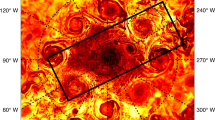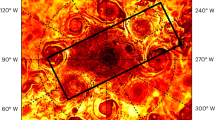Abstract
The Juno mission observed that both poles of Jupiter have polar cyclones that are surrounded by a ring of circumpolar cyclones (CPCs). The north pole holds eight CPCs and the south pole possesses five, with both circumpolar rings positioned along latitude ~84° N/S. Here we explain the location, stability and number of the Jovian CPCs by establishing the primary forces that act on them, which develop because of vorticity gradients in the background of a cyclone. In the meridional direction, the background vorticity varies owing to the planetary sphericity and the presence of the polar cyclone. In the zonal direction, the vorticity varies by the presence of adjacent cyclones in the ring. Our analysis successfully predicts the latitude and number of circumpolar cyclones for both poles, according to the size and spin of the respective polar cyclone. Moreover, the analysis successfully predicts that Jupiter can hold circumpolar cyclones, whereas Saturn currently cannot. The match between the theory and observations implies that vortices in the polar regions of the giant planets are largely governed by barotropic dynamics, and that the movement of other vortices at high latitudes is also driven by interaction with the background vorticity.
This is a preview of subscription content, access via your institution
Access options
Access Nature and 54 other Nature Portfolio journals
Get Nature+, our best-value online-access subscription
$32.99 / 30 days
cancel any time
Subscribe to this journal
Receive 12 print issues and online access
$259.00 per year
only $21.58 per issue
Buy this article
- Purchase on SpringerLink
- Instant access to full article PDF
Prices may be subject to local taxes which are calculated during checkout





Similar content being viewed by others
Data availability
No data sets were generated or analysed during the current study.
Code availability
The MATLAB codes used for calculating and plotting the figures in this paper are available on request from N.G.
References
Bolton, S. J. et al. Jupiter’s interior and deep atmosphere: The initial pole-to-pole passes with the Juno spacecraft. Science 356, 821–825 (2017).
Orton, G. S. et al. The first close-up images of Jupiter’s polar regions: results from the Juno mission JunoCam instrument. Geophys. Res. Lett. 44, 4599–4606 (2017).
Adriani, A. et al. Clusters of cyclones encircling Jupiter’s poles. Nature 555, 216–219 (2018).
Tabataba-Vakili, F. et al. Long-term tracking of circumpolar cyclones on Jupiter from polar observations with JunoCam. Icarus 335, 113405 (2020).
Adriani, A. et al. Two-year observations of the Jupiter polar regions by JIRAM on board Juno. J. Geophys. Res. Planets 125, e2019JE006098 (2020).
Grassi, D. et al. First estimate of wind fields in the Jupiter polar regions from JIRAM-Juno images. J. Geophys. Res. Planets 123, 1511–1524 (2018).
Fine, K., Cass, A., Flynn, W. & Driscoll, C. Relaxation of 2D turbulence to vortex crystals. Phys. Rev. Lett. 75, 3277 (1995).
Schecter, D., Dubin, D., Fine, K. & Driscoll, C. Vortex crystals from 2D Euler flow: experiment and simulation. Phys. Fluids 11, 905–914 (1999).
Showman, A. P., Ingersoll, A. P., Achterberg, R. & Kaspi, Y. in Saturn in the 21st Century (eds Baines, K. H. et al.) 295–366 (Cambridge Univ. Press, 2018).
Kaspi, Y. et al. Comparison of the deep atmospheric dynamics of Jupiter and Saturn in light of the Juno and Cassini gravity measurements. Space Sci. Rev. 216, 84 (2020).
Galanti, E. et al. Saturn’s deep atmospheric flows revealed by the Cassini Grand Finale gravity measurements. Geophys. Res. Lett. 46, 616–624 (2019).
Baines, K. H. et al. Saturn’s north polar cyclone and hexagon at depth revealed by Cassini/VIMS. Planet. Space Sci. 57, 1671–1681 (2009).
Li, C., Ingersoll, A. P., Klipfel, A. P. & Brettle, H. Modeling the stability of polygonal patterns of vortices at the poles of Jupiter as revealed by the Juno spacecraft. Proc. Natl Acad. Sci. USA 117, 24082–24087 (2020).
Yadav, R. K., Heimpel, M. & Bloxham, J. Deep convection-driven vortex formation on Jupiter and Saturn. Sci. Adv. 6, eabb9298 (2020).
Yadav, R. K. & Bloxham, J. Deep rotating convection generates the polar hexagon on Saturn. Proc. Natl Acad. Sci. USA 117, 13991–13996 (2020).
Garcia, F., Chambers, F. R. & Watts, A. L. Deep model simulation of polar vortices in gas giant atmospheres. Mon. Not. R. Astron. Soc. 499, 4698–4715 (2020).
Afanasyev, Y. & Zhang, Y. Cyclonic circulation of Saturn’s atmosphere due to tilted convection. Nat. Geosci. 11, 164–167 (2018).
Afanasyev, Y. & Huang, Y.-C. Poleward translation of vortices due to deep thermal convection on a rotating planet. Geophys. Astrophys. Fluid Dyn. 114, 821–834 (2020).
Aubert, O., Le Bars, M., Le Gal, P. & Marcus, P. S. The universal aspect ratio of vortices in rotating stratified flows: experiments and observations. J. Comp. Phys. 706, 34–45 (2012).
Lemasquerier, D., Facchini, G., Favier, B. & Le Bars, M. Remote determination of the shape of Jupiter’s vortices from laboratory experiments. Nat. Phys. 16, 695–700 (2020).
Rossby, C. On displacements and intensity changes of atmospheric vortices. J. Mar. Res. 7, 71 (1948).
Adem, J. A series solution for the barotropic vorticity equation and its application in the study of atmospheric vortices. Tellus 8, 364–372 (1956).
Smith, R. K., Ulrich, W. & Dietachmayer, G. A numerical study of tropical cyclone motion using a barotropic model. I: the role of vortex asymmetries. Q. J. R. Meteorol. Soc. 116, 337–362 (1990).
Shapiro, L. J. Hurricane vortex motion and evolution in a three-layer model. J. Atmos. Sci. 49, 140–154 (1992).
Smith, R. B. A hurricane beta-drift law. J. Atmos. Sci. 50, 3213–3215 (1993).
Franklin, J. L., Feuer, S. E., Kaplan, J. & Aberson, S. D. Tropical cyclone motion and surrounding flow relationships: searching for beta gyres in Omega dropwindsonde datasets. Mon. Weath. Rev. 124, 64–84 (1996).
Chan, J. C. The physics of tropical cyclone motion. Ann. Rev. Fluid Mech. 37, 99–128 (2005).
O’Neill, M. E., Emanuel, K. A. & Flierl, G. R. Polar vortex formation in giant-planet atmospheres due to moist convection. Nat. Geosci. 8, 523–526 (2015).
O’Neill, M. E., Emanuel, K. A. & Flierl, G. R. Weak jets and strong cyclones: shallow-water modeling of giant planet polar caps. J. Atmos. Sci. 73, 1841–1855 (2016).
Scott, R. Polar accumulation of cyclonic vorticity. Geophys. Astrophys. Fluid Dyn. 105, 409–420 (2011).
Brueshaber, S. R., Sayanagi, K. M. & Dowling, T. E. Dynamical regimes of giant planet polar vortices. Icarus 323, 46–61 (2019).
Zhao, H., Wu, L. & Zhou, W. Observational relationship of climatologic beta drift with large-scale environmental flows. Geophys. Res. Lett. 36, L1880 (2009).
Rivière, G., Arbogast, P., Lapeyre, G. & Maynard, K. A. A potential vorticity perspective on the motion of a mid-latitude winter storm. Geophys. Res. Lett. 39, L1280 (2012).
Fiorino, M. & Elsberry, R. L. Some aspects of vortex structure related to tropical cyclone motion. J. Atmos. Sci. 46, 975–990 (1989).
Sutyrin, G. G. & Flierl, G. R. Intense vortex motion on the beta plane: development of the beta gyres. J. Atmos. Sci. 51, 773–790 (1994).
Vallis, G. K. Atmospheric and Oceanic Fluid Dynamics (Cambridge Univ. Press, 2017).
Sayanagi, K. M., Blalock, J. J., Dyudina, U. A., Ewald, S. P. & Ingersoll, A. P. Cassini ISS observation of Saturn’s north polar vortex and comparison to the south polar vortex. Icarus 285, 68–82 (2017).
Acknowledgements
We thank K. Duer and E. Galanti for insightful conversations. This research was supported by the Minerva Foundation with funding from the Federal German Ministry for Education and Research, the Israeli Space Agency and the Helen Kimmel Center for Planetary Science at the Weizmann Institute of Science.
Author information
Authors and Affiliations
Contributions
N.G. designed the study, performed the calculations and wrote the paper together with Y.K.
Corresponding author
Ethics declarations
Competing interests
The authors declare no competing interests.
Additional information
Peer review information Primary Handling Editor: Stefan Lachowycz. Nature Geoscience thanks Yakov Afanasyev and the other, anonymous, reviewer(s) for their contribution to the peer review of this work.
Publisher’s note Springer Nature remains neutral with regard to jurisdictional claims in published maps and institutional affiliations.
Extended data
Extended Data Fig. 1 Measurements of the Jovian PC velocity profiles.
The velocity profiles from Extended Data Fig. 3a, overlaid on Fig. 6 from Grassi et al., 20186 (adapted with permission), showing the observed velocities around the north (a) and south (b) poles of Jupiter. The idealized velocity profiles are calculated using the Jovian values for R and V (Methods). The green curves (vPC) represent the velocity profiles used for the analyses in this study.
Extended Data Fig. 2 Measurements of the Saturnian PC velocity profiles.
Two velocity profiles from Extended Data Fig. 3a, overlaid on Fig. 8 from Baines et al., 200912 (adapted with permission), showing the observed velocities around the north (solid) and south (dashed) poles of Saturn. Error bars are calculated as standard deviations12. The idealized velocity profiles are calculated using the Saturnian values for R and V (Methods). The green curves (vPC) represent the velocity profiles used for the analyses in this study.
Extended Data Fig. 3 Idealized profiles of velocity, vorticity, and vorticity gradient.
a, The vortex velocity profile according to the suggested piece-wise function (green solid curve) from equation (6) compared with two other ideal vortex profiles6,23 (for the Grassi curve6, γ = 1.5 is taken). b, The vorticity calculated for the same profiles as a. c, Vorticity gradient (in log scale), calculated for the same three profiles. In addition, the minus of the β profiles are shown for the northern and southern poles of Saturn and Jupiter. The 4 curves for − β differentiate as the vorticity gradient is normalized according to each polar cyclone, and as the length is scaled by the radius of maximum velocity for the respective PC. The points where the vorticity gradient curves cross the − β curves represent equilibrium. Here, 0 in the r/R axis represents the pole.
Rights and permissions
About this article
Cite this article
Gavriel, N., Kaspi, Y. The number and location of Jupiter’s circumpolar cyclones explained by vorticity dynamics. Nat. Geosci. 14, 559–563 (2021). https://doi.org/10.1038/s41561-021-00781-6
Received:
Accepted:
Published:
Issue Date:
DOI: https://doi.org/10.1038/s41561-021-00781-6
This article is cited by
-
Observational evidence for cylindrically oriented zonal flows on Jupiter
Nature Astronomy (2023)
-
Jupiter Science Enabled by ESA’s Jupiter Icy Moons Explorer
Space Science Reviews (2023)
-
Moist convection drives an upscale energy transfer at Jovian high latitudes
Nature Physics (2022)
-
From storms to cyclones at Jupiter’s poles
Nature Physics (2022)



